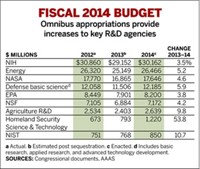Advertisement
Grab your lab coat. Let's get started
Welcome!
Welcome!
Create an account below to get 6 C&EN articles per month, receive newsletters and more - all free.
It seems this is your first time logging in online. Please enter the following information to continue.
As an ACS member you automatically get access to this site. All we need is few more details to create your reading experience.
Not you? Sign in with a different account.
Not you? Sign in with a different account.
ERROR 1
ERROR 1
ERROR 2
ERROR 2
ERROR 2
ERROR 2
ERROR 2
Password and Confirm password must match.
If you have an ACS member number, please enter it here so we can link this account to your membership. (optional)
ERROR 2
ACS values your privacy. By submitting your information, you are gaining access to C&EN and subscribing to our weekly newsletter. We use the information you provide to make your reading experience better, and we will never sell your data to third party members.
Policy
More Support For Science
President's 2012 budget proposal provides continued growth for science
by Government & Policy Department
February 28, 2011
| A version of this story appeared in
Volume 89, Issue 9
Fluid And Complicated. These are the two words that best describe the current federal budget. With Congress still debating potential deep cuts to the fiscal 2011 budget (see page 7), President Barack Obama has rolled out his request for fiscal 2012.
COVER STORY
More Support For Science
The absence of an enacted 2011 appropriation creates a challenge for determining which agencies might gain and lose from the President’s proposed budget. In most cases, agencies are reporting 2011 budget values based on a continuing budget resolution that essentially funds the federal government at 2010 levels. The stopgap measure—in place since Oct. 1, 2010, the start of fiscal 2011—runs out on March 4, and without congressional action to extend it, the government will shut down.
As a result, in this year’s budget documents, some agencies compared their 2012 proposals to the 2010 appropriation, and some compared their proposed funding to a projection of the continuing resolution.
With this uncertainty as a backdrop, the President’s $3.7 trillion budget request for 2012 holds discretionary funding flat but does provide some targeted gains for science. For R&D overall, the request keeps funding at $148 billion, but for nondefense R&D, Obama is providing a 6.5% increase to $66.8 billion. This increase supports the President’s priorities of driving innovation and improving science, technology, engineering, and mathematics (STEM) education.
The President, who continues to call for science and technology support, said innovation and education are an essential part of his budget blueprint. “I’m convinced that if we outbuild and out-innovate and out-educate, as well as out-hustle the rest of the world, the jobs and industries of our time will take root here in the United States. Our people will prosper and our country will succeed,” he said when rolling out the budget on Feb. 14.
Beyond the fluid 2011 budget picture, the following review of proposed R&D spending at the federal agencies comes with some other caveats. The numbers are given mostly as budget obligations; that is, the money that agencies can contract to spend during the fiscal year. This may be more or less than the agencies actually spend, or outlay, during the year.
Also, the federal budget is a complicated document with various ways of adding up programs and totals. As a result, figures from an agency or department may differ from those generated by the White House Office of Management & Budget. These variations are usually small, however, and reflect alternative methods of dividing funds.
The Budget Process. The fiscal 2012 budget now goes to the House and Senate Appropriations Committees, where it is divided into several appropriations bills. Hearings will be held on each bill by various committees, and legislation will emerge that sets the levels of spending for all federal departments and agencies. The numbers approved by Congress may be very different from those originally proposed by the Administration, but historically, R&D has not been radically changed. The whole process is supposed to be completed and the appropriations bills signed by the President by Sept. 30, the last day of fiscal 2011.






Join the conversation
Contact the reporter
Submit a Letter to the Editor for publication
Engage with us on Twitter